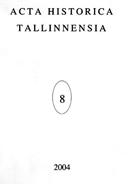Institutsioonide roll nõukogude kunstipoliitikas ning neist lahtirakendamise mõjud 1990. Aastatel
The Role of Institutions in Soviet Art Policy and Effects of Disinstitutionalisation in the 1990s
Author(s): Raili NuginSubject(s): Cultural history
Published by: Teaduste Akadeemia Kirjastus
Keywords: Estonia; Estonian History; Role of Institutions ; Soviet Art Policy ; Disinstitutionalisation ; 1990s
Summary/Abstract: The article analyses the role of institutions in Soviet art policy and its reflections during the period of regaining the independence and its aftermath in Estonia. It is argued that since the Stalinist official art was a product of social processes initiated in Russia, the outcome was alien to Estonian society. Thus, the methods of the implementation of the model become especially important. One of the most important ways to control the artists was the thorough system of institutions, which helped to accomplish the regime’s disciplinary and control mechanisms. The surveillance lines, however, were often double or vaguely defined. Thus, on one hand, the institutions created a milieu of established discipline rituals. On the other hand, the political elite could break those rituals, interfering into art life randomly, making the objects feel uncertain about the control lines, consequently always alert. After the death of Stalin the institutional rituals lost gradually their role as creators of vagueness, but the disciplinary rituals remained. Paradoxically, these rituals created a feeling of certainty and ontological security. The implemented rituals that worked for decades prevented those in the institutions from thinking too much about the existential questions of identity or ideology and they acted according to the roles acquired. After the collapse of the Soviet Union a certain ideological and institutional vacuum emerged. At first the ideological vacuum was filled with a value structure similar to that of Soviet times, but the layers of that structure were filled in with different values. The pathos and demagogy used by the Soviet elite remained the same in the discourse of the leaders of art institutions. Similarly to Soviet times, it was claimed that society rested on ideology and cultural identity. As for the institutional vacuum, it reflects a cultural trauma. People talk about the baneful new system, which can lead the artists and the entire society to doom. Yet, at first the artists do not admit the need to change themselves. Step by step the institutional problems take over the ideological discourse about identity. Steps are taken to survive in the present situations and all the energy is committed to survival. Thus, gradually the ideological discourse stays behind and transforms into the concept that art and culture is just one side of society. Society does not rest or depend on culture any more.
Journal: Acta Historica Tallinnensia
- Issue Year: 2004
- Issue No: 08
- Page Range: 061-076
- Page Count: 16
- Language: Estonian

